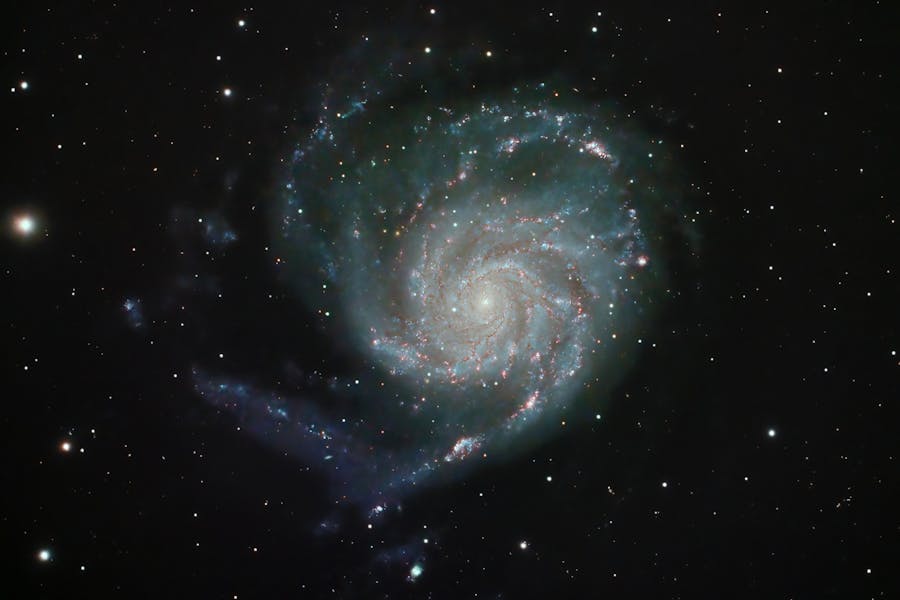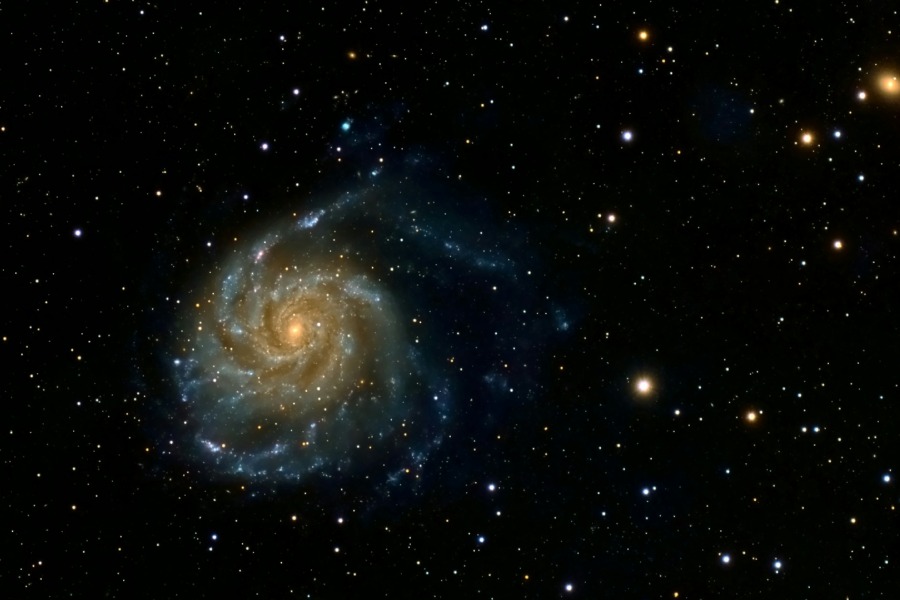The Pinwheel Galaxy is one of the most recognizable and photogenic of the countless galaxies in our universe. Located over 21 million light-years away in Ursa Major’s constellation, the Pinwheel Galaxy reveals stunning spiral arms in deep space images. So, what are some of the most intriguing Pinwheel Galaxy facts?
In this article, we will explore some interesting facts about the Pinwheel Galaxy, from its structure and contents to its history of observations. We will examine how its two main spiral arms gave rise to its popular name. We will also look at why it is classified as a starburst galaxy.
History of Pinwheel Galaxy
Numerous astronomers played crucial roles in unraveling the mysteries of the Pinwheel Galaxy. First, Charles Messier classified it as the 101st object in his catalog. Later, William Parsons depicted its spiral structure through sketches using the Leviathan of Parsonstown.
Additionally, Heber Curtis determined its distance, while Edwin Hubble expanded our cosmic understanding by identifying galaxies beyond the Milky Way. Together, their combined observations elevated the Pinwheel from a mere entry in Messier’s catalog to a recognized spiral galaxy.

Structure of the Pinwheel Galaxy
Architectural marvel
The Pinwheel Galaxy, spanning 170,000 light-years, boasts a classic spiral shape. Viewed from Earth, it presents a nearly face-on perspective, highlighting its intricate structure.
Two prominent spiral arms gracefully extend from the core, adorned with star clusters and nebulae. These arms harbor significant amounts of gas and dust, fostering the birth of new stars. Additionally, fainter arms radiate outward, creating a breathtaking celestial pinwheel.
Spirals and bars
The Pinwheel’s prominent arms suggest a density wave in the disk. These distinct arms extend from the ends of a small central bar. This bar plays a role in channeling gas toward the nucleus, leading to starburst activity.
The bar appears shorter because we look at the galaxy from the front. The combination of spirals and the bar accentuates the Pinwheel’s structural elegance.
Properties of the Pinwheel Galaxy
Galactic fundamentals
The Pinwheel Galaxy has a diameter of about 170,000 light-years and a mass of 1 trillion solar masses. It shines with a luminosity of 10 billion times that of our Sun.
The galaxy rotates at 163 km/s (101 mi/s) based on the speed of gas in the disk. These values provide baseline knowledge of the galaxy.
The Pinwheel Galaxy’s distance from Earth is estimated to be 21 million light-years. It occupies a region of the night sky within the constellations of Ursa Major.
Dynamics and evolution
The Pinwheel’s rotation and mass distribution reveal insights into its dynamics and history. The bar and arms channel gas, fostering active star formation.
Also, examining the galaxy’s spiral structure and angular momentum through observations gives clues about its evolution spanning billions of years. Likely, mergers and interactions have played a role in shaping the Pinwheel Galaxy into its current form.
Distance From Earth to the Pinwheel Galaxy
The Pinwheel Galaxy’s distance is calculated by astronomers using redshift and standard candles, such as Cepheid variables. Redshift measurement reveals the galaxy’s velocity moving away from us.
Distance estimates are derived from their periodic brightness variations by assessing the luminosity of Cepheids in the Pinwheel and comparing them to those in our galaxy. The integration of these methods refines the Pinwheel Galaxy’s distance to approximately 21 million light-years.
Age of the Pinwheel Galaxy
Stellar chronology
Like the Milky Way, the Pinwheel Galaxy is approximately 13.2 billion years old. Scientists determine this age by studying the different types of stars it contains.
Red giant stars represent older populations, whereas hot, massive stars indicate newer star formation. The coexistence of these age groups suggests continuous star formation spanning billions of years.
Challenges and uncertainties
Galactic ages are hard to pin down due to uncertainties. Stars take a long time to form, which complicates age dating.
Moreover, interactions with other galaxies and occasional starbursts add to the challenge of estimating ages. Despite these challenges, the Pinwheel Galaxy seems to be around 13 billion years old. However, future observations will likely refine this estimate due to uncertainties.

Conclusion
The Pinwheel Galaxy captivates us with its poetic beauty and complex structure. Located 21 million light-years away in the constellation Ursa Major, it reveals intricate spiral arms.
These arms are swirling outward from its bright core when viewed through a telescope. These key Pinwheel Galaxy facts covered in this article include its designation as a starburst galaxy.
This is due to its high rate of star formation. Also, its enormous size spanning 170,000 light-years, and its status as the most luminous galaxy in the northern portion of the sky.
While many mysteries remain unsolved, continued research helps unwrap the secrets of this cosmic pinwheel. Its elegant form inspires awe and curiosity about the Pinwheel Galaxy and our vast universe’s workings. As telescopes advance, we move closer to unraveling the unknowns of this celestial wonder, the Pinwheel.
